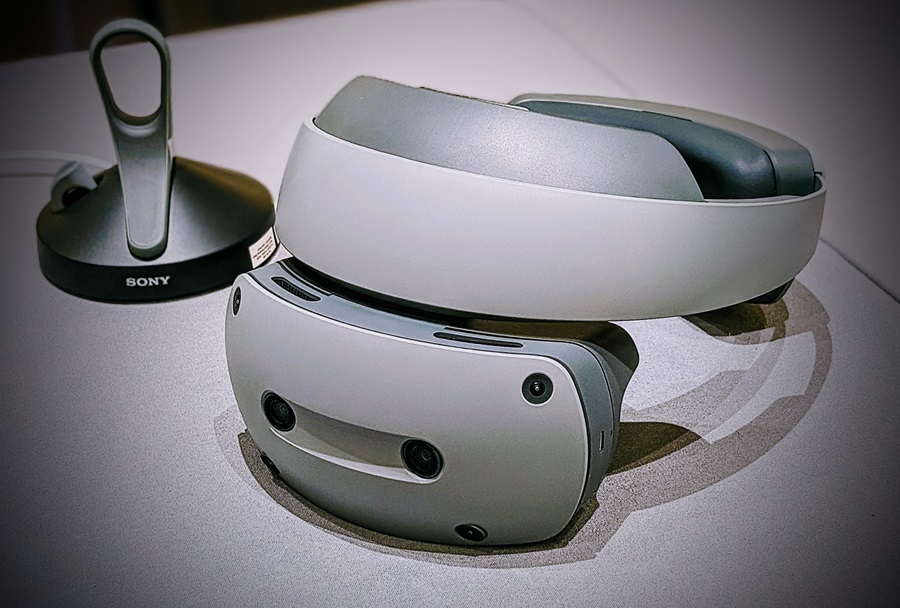
In General XR News
January 16, 2024 – Sony recently unveiled its plans to develop a new immersive spatial content creation system aimed at supporting sophisticated 3D content creation across the entertainment and industrial design fields. Part of this ecosystem will include the company’s new XR head-mounted display (HMD), which has yet to publicly be given an official name.
To introduce its new solution for immersive design, Sony has exclusively partnered with Siemens, a leader in industrial technology. Integrated into the headset is Siemens’ new NX Immersive Designer software.
At CES in Las Vegas last week, I was able to give this new headset a try in a short demo that highlighted some of the device’s features and functionality. Here’s how it went:
The Visual Experience
The new headset uses OLED Microdisplays and pancake optics to provide a resolution of 4K per eye, and let me start by saying that the quality of visuals on Sony’s XR HMD was absolutely stunning. Upon putting the headset on, I was instantly reminded of how I felt the very first time I ever tried on a Varjo headset capable of human-eye resolution. Except, that was back in 2019 with the Varjo XR-1 Developer Edition. In the five years since, I’ve tried a lot of XR headsets out, and that same feeling of profundity has been harder to come by. However, this experience was (for me at least) similarly profound.
The demo featured a page from a book that you could pick up and bring closer/move further away from your face using the controller (more on that shortly), with text that appeared to be probably a size 7 or 8 font (by MS Word/Google Docs comparison). There were zero issues in discerning the text on the page, and as someone who needs reading glasses to read smaller text, I did not have any issues reading this even without my glasses on. The image was sharp and crisp, and there was not a hint of any screen door effect at any point using the device – something that is often more noticeable when you are looking at a high contrast image such as black text on a white page.
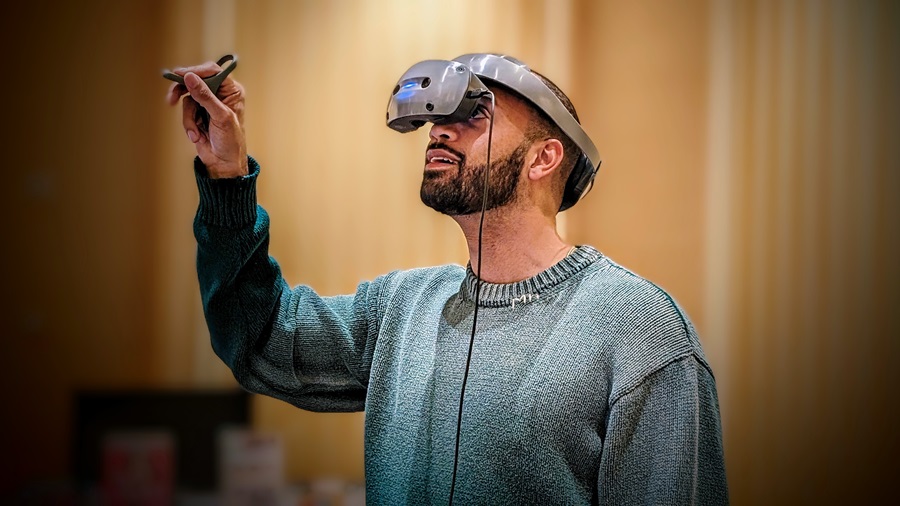
So, straight out of the gate, the resolution on this HMD was, in my opinion, at least comparable to a Varjo device that offered ‘human-eye’ quality resolution. Other aspects of the demo that showcased the headset’s visual capabilities included admiring an intricate work of art where you could go up close and see individual brush strokes on the canvas. There were also some Micro SD cards floating in the space that you could pick up and interact with, and again, the level of detail on these small props that the headset was able to display was truly impressive, whether it was the minute gaps and separation of the copper contact pins on the card, or the text itself showing the storage capacity of the card (again, this was a Micro SD card).
And staying true to their brand, there was also a Sony DSLR camera that you could interact with and take photos with whilst in the virtual world. Viewing these photos on the virtual camera’s LCD display was also clear and crisp, even at this shrunk down level of Inception-style content viewing (a fun passthrough feature here would be to allow the virtual DSLR to act as a viewfinder to the real world outside of any immersive experience).
Design and Usability
The device features a single solid head strap that tightens at the rear and comfort-wise, I experienced no issues with the headset. Granted it was a relatively short demo, so I can’t speak to how it might feel after an hour of wearing it. But for the 10 minutes or so that I was using the device, there were none of the telltale signs of a poorly fitting unit. Additionally, Sony had been running demos all day (this being what was also probably the third day of demos). That being said, the headset didn’t feel hot, and there were zero issues of lag whilst in the demo experience.
The device was tethered to a laptop device for this demo experience too, but whether or not this would need to be the case for all experiences on the headset is to be determined. This is because the device is one of at least five that is utilizing the recently announced Snapdragon XR2+ Gen 2 Platform from Qualcomm. With that chipset, the headset should be able to handle complax XR experiences as a standalone unit. However, for this particular demo, it appears that the USB-C tether to a laptop was required to power the Siemens NX Immersive Designer software.
Although capable of video passthrough, the HMD also features a flip-up design for quick switching between immersive experiences and the real world, similar to devices such as the Lynx R-1.
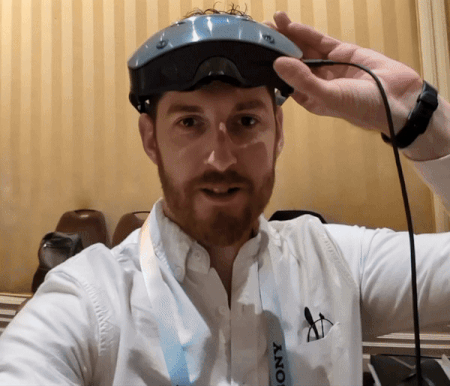
This ease of switching between realities is actually something that I have grown quite fond of as a feature in XR headsets, as it is just a very simple solution to one of my biggest gripes with using VR, which is the hassle of having to constantly take a headset on and off again during setup/general use/task switching. While some combination of tapping the side of a headset to activate passthrough is good, it is not always perfect.
Instead, being able to simply flip up the display and instantly remove yourself from the virtual world for a moment is simple, effective, and doesn’t require any additional processing power. This will also likely be a feature popular amongst designers, creatives and anyone else who has to switch between immersive content and real life drawings or scale models.
It is no surprise then that Sony is positioning this headset towards those sorts of end users. Anyone working in industrial design, AEC, or professional creative industries will be the target recipients of this piece of technology. This is also where the headset’s controllers come in.
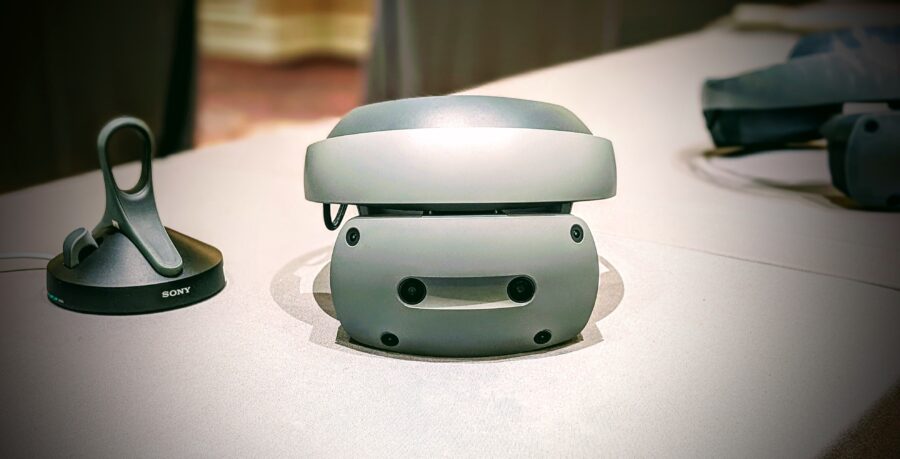
Sony’s new Pointing and Ring Controllers for XR
Referred to simply as the “pointing controller” during the demo, the clue is in the name. This new type of controller from Sony is really designed to allow users to interact with their 3D content on a very precise level. The controller is held between your index finger and thumb, and is capable of providing haptic feedback, as well as acting as a button for clicking/holding/grabbing in virtual environments. Plus, although my demo didn’t really highlight this functionality specifically, there was enough space on the index finger side of the controller for what could presumably also include a trackpad too.
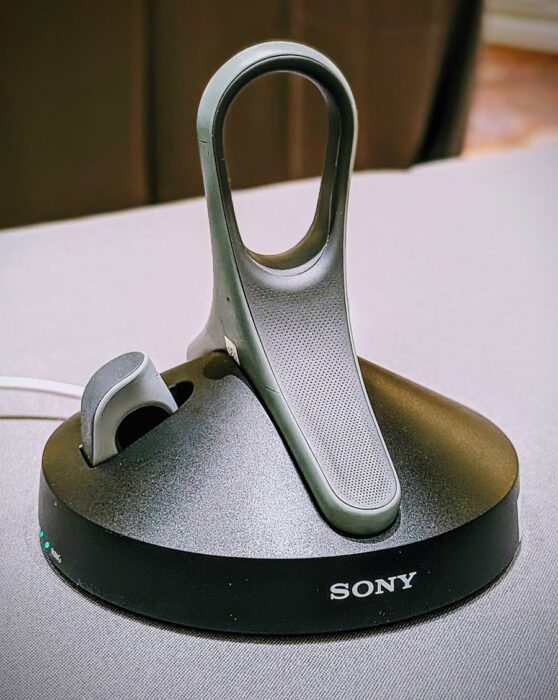
It is almost like this new controller provides a perfect bridge between the freedom of hand tracking and the guaranteed level of interaction and feedback that a physical controller offers. It doesn’t require your entire hand to hold and grip the controller, freeing you up to potentially still do things like type or grip other physical objects, yet it is able to provide a more consistent and reliable level of interaction with virtual objects, as there are no hand tracking-style issues that can arise (such as reduced accuracy in poor lighting or occlusion issues).
In addition to this pointing controller, there is also a ring that is worn on your other hand. The headset is capable of hand tracking though, and this ring is in part for helping to enhance the tracking when a user is manipulating objects in virtual space.
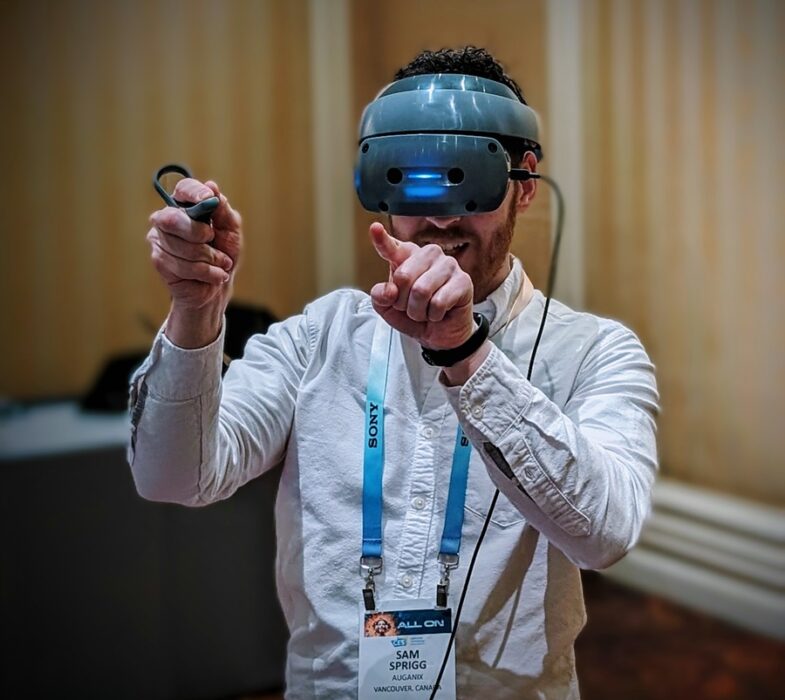
Will Sony’s XR Headset be a Vision Pro Competitor?
Sony is taking a similar approach to Apple in that it is aiming its new XR HMD at professional users. This of course makes sense, as it already has the gaming and entertainment side of things handled by its PSVR2 product line. This new headset from Sony is therefore likely going to be aimed at users working in the AEC and professional creative industries, wherein there is a need for immersive and collaborative 3D creation and modeling tools.
It is hard to say at this time exactly how this device will measure up to the Apple Vision Pro as there is simply still a lot that we don’t know about Sony’s headset. This includes information such as pricing, release date, and full specifications. However, these first impressions are very positive and a device such as this certainly has the potential to impact the workflows of the creative and professional industries.
Plus, with Sony’s expansive entertainment division already nurturing a vast network of creative professionals, the introduction of the company’s new XR headset could significantly impact the creative landscape within Sony’s own content ecosystem. If Sony positions this device as a standard tool within its ecosystem, it could become an essential asset for professionals in immersive content creation in the future.
Image credit: Auganix
About the author
Sam is the Founder and Managing Editor of Auganix. With a background in research and report writing, he has been covering XR industry news for the past seven years.
